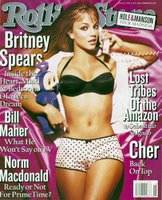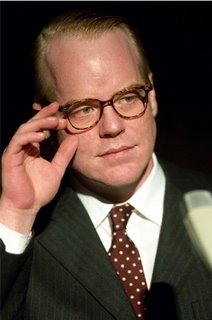David LaChapelle: Defining Renaissance Pop Art
 With the fleeting glory of the entertainment industry it is difficult for any artist to maintain respect and creative recognition from peers, clients, and the general public for a substantial amount of time. Making a name for oneself based purely on creativity and imagination is a complicated and often competitive task to complete on a professional level. Those who accomplish this goal often receive various forms of public recognition, including honorary degrees from prestigious academic institutions. Honoring professionals of fine arts is a celebrated and longstanding tradition of colleges and universities across the nation. At the 2007 Spring Commencement Ceremony, the
With the fleeting glory of the entertainment industry it is difficult for any artist to maintain respect and creative recognition from peers, clients, and the general public for a substantial amount of time. Making a name for oneself based purely on creativity and imagination is a complicated and often competitive task to complete on a professional level. Those who accomplish this goal often receive various forms of public recognition, including honorary degrees from prestigious academic institutions. Honoring professionals of fine arts is a celebrated and longstanding tradition of colleges and universities across the nation. At the 2007 Spring Commencement Ceremony, the
Many academic professionals would prefer to keep the world of pop culture outside of the public ritual of awarding honorary degrees. The controversial content of David LaChapelle’s work, his notorious celebrity reputation, and his sexual orientation does not presumably fit into the standard persona of doctoral degree recipients. In his book, Liberal Education and the Public Interest, James Freedman asserts that in recent years the Honorary Degree process excessively “bows to celebrity culture” (127). Giving an award to a photographer whose work consists of mainly celebrity iconography may seem to emulate this trend. In fact, Freedman might argue that LaChapelle’s work is not of the intellectual caliber of other reputable artists. He claims that “any aspiration to populate an American peerage is surely trivialized…by awarding an institution’s ultimate accolade to mere celebrities” (126). However, David LaChapelle’s commercial endeavors cannot be dismissed as trivial simply because they are not heavily featured in scholastic settings. Celebrated as the “Fellini of photography” by the New York Times, LaChapelle has clearly transcended the status of mere celebrity into a valid and respectable artist. Although the honorary degree process is not a popularity contest, one might suggest that in the world of popular entertainment, where everything is subject to competition, it is refreshing to have someone like LaChapelle emerge through all the monotony of mainstream popular art and culture.
The work David LaChapelle has produced in the span of his career has been popularized and highly acclaimed all over the world. His career started with the help of notorious photographer Andy Warhol, who gave LaChapelle his first professional job offer shooting for Interview magazine. Since then La Chapelle's photographs have appeared on and in between the covers of big name fashion and celebrity magazines such as Italian Vogue, Vanity Fair, and Rolling Stone. Over the last decade he has published distinguished compilation books of photography, including
LaChapelle’s images are an obscure embodiment of high and low art that is exceedingly prevalent in film, music, literature, and other cultural texts. LaChapelle’s work surreally captures what has come to be known as the Post-Modern aesthetic.  His use of intertexual references as well as the highly contextual mode of representation used in his short films and videos makes LaChapelle’s work exceptionally distinctive to contemporary generations. The homepage of his official website asserts that LaChapelle has utilized such “diverse sources as renaissance art history, cinema, The Bible, pornography, and the new globalized pop culture.” With these referential elements, his celebrity portraits often contain hints of irony and ridicule, all the while glorifying the subject with color soaked sheen. LaChapelle’s mode of representation is summed up as a “deeply personal and epoch-defining visual language that holds a mirror to the face of our times, reflecting back both the sacred and profane.” The campy buoyant wit of LaChapelle’s surreal human portraits coupled with the digitally saturated color makes his photography exceptional and worthy of recognition from USC. His patterns, colors, choreography and detail are the work of a master-craftsman.
His use of intertexual references as well as the highly contextual mode of representation used in his short films and videos makes LaChapelle’s work exceptionally distinctive to contemporary generations. The homepage of his official website asserts that LaChapelle has utilized such “diverse sources as renaissance art history, cinema, The Bible, pornography, and the new globalized pop culture.” With these referential elements, his celebrity portraits often contain hints of irony and ridicule, all the while glorifying the subject with color soaked sheen. LaChapelle’s mode of representation is summed up as a “deeply personal and epoch-defining visual language that holds a mirror to the face of our times, reflecting back both the sacred and profane.” The campy buoyant wit of LaChapelle’s surreal human portraits coupled with the digitally saturated color makes his photography exceptional and worthy of recognition from USC. His patterns, colors, choreography and detail are the work of a master-craftsman.
Although LaChapelle’s formal techniques are undeniably unique and respectable, the highly sexual content in some of his videos and photography could be construed as excessively vulgar and outrageous. This could be problematic for the USC honorary degree committee as this particular work may not “elevate the university in the eyes of the world” but have the opposite affect. One particular photo series that exemplifies this problem is the 1999 Rolling  Stone photo shoot featuring a 17 year-old Britney Spears in sexually suggestive Lolita-themed poses. In response to the photos, a representative from the American Family Association stated that the “mixing of childhood innocence with adult sexuality is troubling." This is noted in a 1999 articleThe Spokemans Review. Of course, most of the responsibility for this controversy was put on the pop star, jabbing at Spears’ ability to be a role model for young fans. Nevertheless, this incident shows that LaChapelle’s merging of celebrity and established cultural imagery evokes reaction. He should be commended for successfully arousing conversation about the touchy subject matter through pop art. in
Stone photo shoot featuring a 17 year-old Britney Spears in sexually suggestive Lolita-themed poses. In response to the photos, a representative from the American Family Association stated that the “mixing of childhood innocence with adult sexuality is troubling." This is noted in a 1999 articleThe Spokemans Review. Of course, most of the responsibility for this controversy was put on the pop star, jabbing at Spears’ ability to be a role model for young fans. Nevertheless, this incident shows that LaChapelle’s merging of celebrity and established cultural imagery evokes reaction. He should be commended for successfully arousing conversation about the touchy subject matter through pop art. in
Although much of LaChapelle’s work is laced with spectacle, it does contain valuable meaning and insight. In his book Meaningful Work: Rethinking Professional Ethics, Mike Martin identifies three areas of personal success for professional individuals. The area most relevant and vital for honorary degree recipients is moral concern. One definition of moral concern is the “desire to enter into and sustain caring relationships with clients, customers, colleagues, and the wider community” (23). The production of artwork is inseparably tied to the artist’s moral concern for his or her audience. As David LaChapelle’s work is often aimed at mass audiences, he has the ability to communicate with a large ranging community. LaChapelle’s moral concern is found in his communication of deeper meaning and commentary on cultural oddities, social problems, and current political issues in his widely distributed images. This concern is aligned with USC’s central mission statement which aims at enriching the lives of every human being. LaChapelle’s does this through art. His moral concern is evident in the following examples.
In preparation for the 2004 elections, Declare Yourself, a nonpartisan voter-registration group, raised two giant billboards in  0 with their mouths held shut, next to the message, "Only you can silence yourself." LaChapelle is responsible for this ad campaign which also includes two short commercials viewable on his website. The spots include parodies of makeup and pet food commercials before turning a sharp corner to depict the sealing, bolting or muzzling of stars' mouths. This highly confrontational ad campaign has proved necessary to grab the short attention spans of younger generations. As noted in the New York Times article entitled Getting Out the Vote, With Style, this ad campaign was meant to sell a cause as if it were a brand. LaChapelle’s efforts to capture the attention of audiences by fusing eye-catching concepts with celebrity star power is a viable method to promote change in a generation that has grown accustomed to tuning out pretty much everything but the entertainment world.
0 with their mouths held shut, next to the message, "Only you can silence yourself." LaChapelle is responsible for this ad campaign which also includes two short commercials viewable on his website. The spots include parodies of makeup and pet food commercials before turning a sharp corner to depict the sealing, bolting or muzzling of stars' mouths. This highly confrontational ad campaign has proved necessary to grab the short attention spans of younger generations. As noted in the New York Times article entitled Getting Out the Vote, With Style, this ad campaign was meant to sell a cause as if it were a brand. LaChapelle’s efforts to capture the attention of audiences by fusing eye-catching concepts with celebrity star power is a viable method to promote change in a generation that has grown accustomed to tuning out pretty much everything but the entertainment world.
 own as krumping, which flourishes in some African-American neighborhoods in the greater
own as krumping, which flourishes in some African-American neighborhoods in the greater
 community.” LaChapelle has handled the issue of sexuality in the public eye in a firm and honest manner, not shying away from the subject, both personally and professionally. In an interview with The Advocate, a popular gay political magazine, LaChapelle addresses how his sexual identity has shaped his artwork, stating, “Being gay, you see the world as an outsider…it makes you escape in your head, and it makes you more creative.” One of the most infamous examples of LaChapelle’s art as a vehicle for LGBT visibility is found in a 1996 Diesel Jeans ad. This photo depicts a passionate kiss between two hunky male sailors. In an earlier interview with The Advocate, LaChapelle states that “Diesel ran that ad in 67 countries around the world…I would have loved to have seen an image like that when I was 15, it would have meant a lot to me.” The ad has been interpreted as a fashionably correct commentary on the ongoing controversy about gays and lesbians in the military. It is a snappy and polished example of LaChapelle’s ability to weave controversial subject matters into lighthearted and free flowing images. LaChapelle’s use of LGBT content in his work coincides with Mike Martin’s notion that personal ideas “contribute to the overall coherence and significance of professional endeavors” (21). LaChapelle successfully takes personal experiences and transforms them into public agenda.
community.” LaChapelle has handled the issue of sexuality in the public eye in a firm and honest manner, not shying away from the subject, both personally and professionally. In an interview with The Advocate, a popular gay political magazine, LaChapelle addresses how his sexual identity has shaped his artwork, stating, “Being gay, you see the world as an outsider…it makes you escape in your head, and it makes you more creative.” One of the most infamous examples of LaChapelle’s art as a vehicle for LGBT visibility is found in a 1996 Diesel Jeans ad. This photo depicts a passionate kiss between two hunky male sailors. In an earlier interview with The Advocate, LaChapelle states that “Diesel ran that ad in 67 countries around the world…I would have loved to have seen an image like that when I was 15, it would have meant a lot to me.” The ad has been interpreted as a fashionably correct commentary on the ongoing controversy about gays and lesbians in the military. It is a snappy and polished example of LaChapelle’s ability to weave controversial subject matters into lighthearted and free flowing images. LaChapelle’s use of LGBT content in his work coincides with Mike Martin’s notion that personal ideas “contribute to the overall coherence and significance of professional endeavors” (21). LaChapelle successfully takes personal experiences and transforms them into public agenda.
 From images of the most famous faces in the world to marginalized figures like transsexual model Amanda Lepore or the cast of his critically acclaimed social documentary Rize, David LaChapelle uses his creativity to challenge and invoke new ideas about glamour, gender, sexuality, class, and the overarching world around us. Most people in this country, including the graduates after the commencement, will rarely read highly academic texts, frequently visit high art museums, or learn about great advances in the sciences, however many will see and read magazines, stare at billboards, and watch commercials. Within all of these facets of mainstream culture exists the artistic expression and stunning works of David LaChapelle. By honoring him, USC would not be succumbing to celebrity culture or contradicting its mission as an institution. Instead it would be proving and reinforcing its values by honoring someone from a diverse background of world-renowned achievement. By honoring David LaChapelle with a doctoral degree of fine arts, the University of Southern California would be acknowledging and embracing an individual whose work brings both humor and intelligence to mainstream mediums that otherwise contain little depth or interpretation.
From images of the most famous faces in the world to marginalized figures like transsexual model Amanda Lepore or the cast of his critically acclaimed social documentary Rize, David LaChapelle uses his creativity to challenge and invoke new ideas about glamour, gender, sexuality, class, and the overarching world around us. Most people in this country, including the graduates after the commencement, will rarely read highly academic texts, frequently visit high art museums, or learn about great advances in the sciences, however many will see and read magazines, stare at billboards, and watch commercials. Within all of these facets of mainstream culture exists the artistic expression and stunning works of David LaChapelle. By honoring him, USC would not be succumbing to celebrity culture or contradicting its mission as an institution. Instead it would be proving and reinforcing its values by honoring someone from a diverse background of world-renowned achievement. By honoring David LaChapelle with a doctoral degree of fine arts, the University of Southern California would be acknowledging and embracing an individual whose work brings both humor and intelligence to mainstream mediums that otherwise contain little depth or interpretation.









